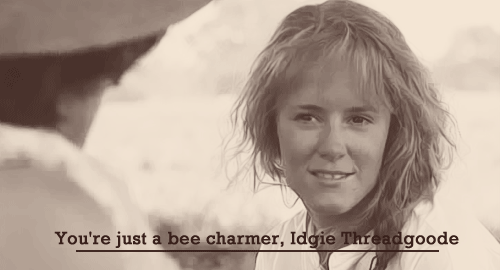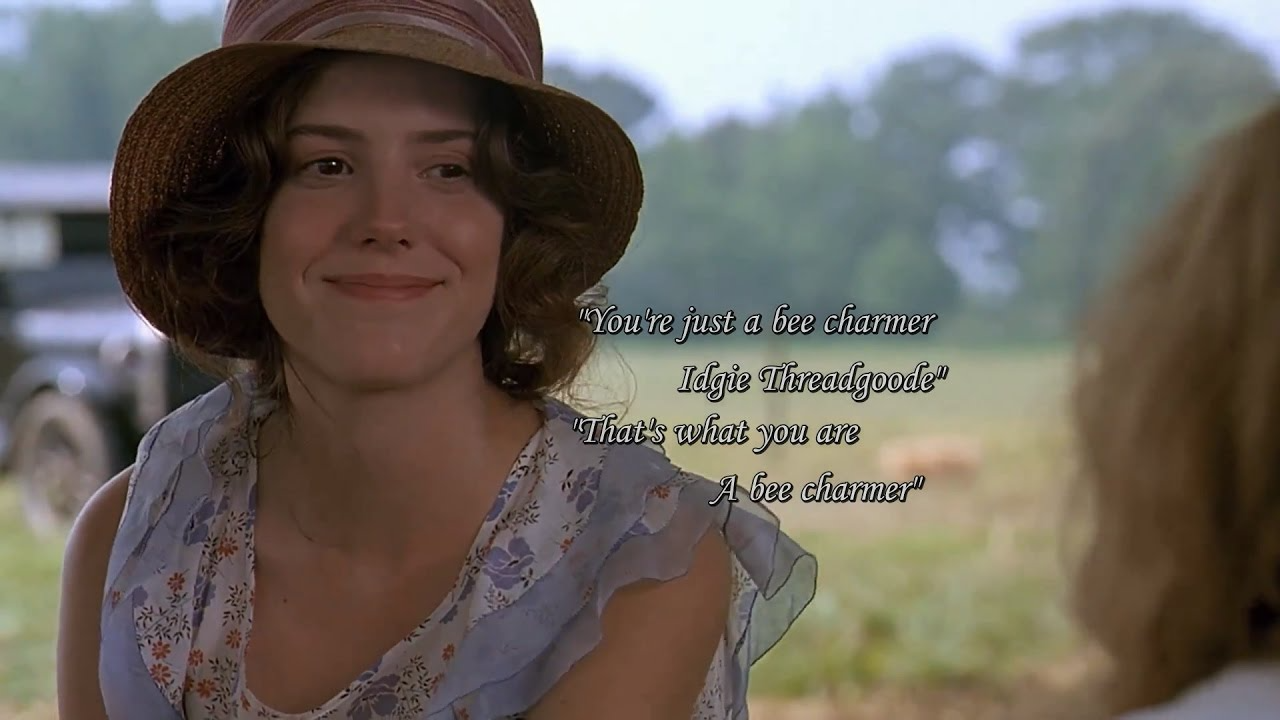
A Scene Dripping with Symbolism and Storytelling
One of the most unforgettable, poetic moments in Fried Green Tomatoes is when Idgie Threadgoode—wild, unruly, and free—walks up to a tree filled with bees, reaches into the hive with bare hands, and pulls out honeycomb. She returns, calm and smiling, with honey dripping from her fingers. She presents it to Ruth with a grin and a wink, declaring herself “The Bee Charmer.”
This moment may appear lighthearted on the surface, even whimsical. But like many iconic scenes in this layered film, the bee charmer scene carries deep symbolic meaning—about fearlessness, about connection, and about the unique love language between Ruth and Idgie.
Idgie the Wild One: Nature as Identity
From the beginning of the film, Idgie Threadgoode is framed as the untamed spirit of Whistle Stop. She roams the forests barefoot, defies every expectation society places on young women, and lives by her own moral compass. She refuses dresses, sermons, and polite conversation, but she is unerringly loyal and courageous.
The scene with the bees reinforces this identity. To approach a buzzing hive without protective gear or hesitation is not just brave—it’s reckless, raw, and elemental. But Idgie doesn’t get stung. The bees recognize her. She belongs to the wild.
This connection to nature positions Idgie as more than a rebel. She becomes a mythic figure—part Huck Finn, part Joan of Arc, part Southern trickster goddess. And in charming the bees, she charms not only Ruth, but the viewer. We understand that she lives by different rules. That what frightens others—whether bees or social convention—never touches her.
Ruth’s Awe: A Turning Point in Their Bond

As Idgie holds out the honeycomb, we see Ruth’s expression shift from surprise to admiration—and then something deeper. In that moment, the tension between the two women begins to bloom into something more profound. It’s not quite romantic in the explicit sense, but the emotional charge is unmistakable.
Idgie doesn’t need words. She doesn’t confess her love. Instead, she performs an act that is tender, daring, and specifically for Ruth. The gift of honey is symbolic: sweet, golden, raw, and earned through courage.
Ruth, who has been raised in a world of manners, scripture, and rigid expectations, sees something in Idgie that shakes her. She sees a life outside the rules—and a person who could offer her not just safety, but freedom.
This is not a flirtation. This is a declaration.
Bees as Symbol: Danger, Reward, and Hidden Power
The bees in this scene are not just insects. They represent a thousand things: fear, danger, community, hidden strength, and sweetness guarded by risk. Approaching them requires bravery. Taking from them without harm requires trust.
In many cultures, bees symbolize resurrection and immortality. They live in tightly knit communities with rigid hierarchies. They produce sweetness from labor. And they will fiercely protect their own.
In this context, Idgie’s act of charming the bees becomes a metaphor for the entire film. It’s about reaching for what matters—family, love, justice—even if it might sting. And doing it with grace.
Idgie isn’t just harvesting honey. She’s showing Ruth—and us—what it means to live with courage, even in the face of danger.
A Scene Without Words, Yet Full of Language
The most remarkable thing about the bee charmer scene is that it contains almost no dialogue. And yet, it is one of the most eloquent moments in the entire film.
There are glances. Movements. The rustle of the woods. The low hum of the hive. Ruth’s gasp. Idgie’s smirk. These elements speak volumes.
This is a moment that trusts the viewer to understand emotional truth without explanation. It respects us enough to let the silence speak. And what it says is this: love doesn’t always need to be spelled out. Sometimes, it’s in the gesture. The risk. The offering.
Echoes in the Present Day: Evelyn’s Transformation Begins Here
Though Evelyn isn’t present in the scene itself, Ninny’s retelling of it sparks something in her. As she listens to the tale of Idgie the Bee Charmer, Evelyn begins to see herself differently.
She, too, has been afraid of being stung—by rejection, by change, by the harsh judgment of a society that tells her what a woman “should” be. But hearing of Idgie’s fearlessness plants a seed in Evelyn: maybe she doesn’t have to be afraid, either.
Maybe she can reach into her own hive of regrets and reclaim something sweet.
A Moment of Cinematic Magic
Visually, the bee charmer scene is one of the most stunning in the film. The way the sunlight filters through the leaves, the close-up of bees crawling peacefully on Idgie’s hands, the golden honey glistening on her fingers—it’s pure visual poetry.
Director Jon Avnet and cinematographer Geoffrey Simpson frame it like a dream, almost as if this moment exists outside time. And in a way, it does. Like many of the film’s best scenes, it’s less about what happens and more about what it means.
Legacy of the Bee Charmer Scene
Over the years, fans of Fried Green Tomatoes have returned to this scene as one of the clearest expressions of the film’s soul. It’s become shorthand for everything Idgie represents: courage, generosity, and deep, unspoken love.
It is quoted. Referenced. Remembered.
And for good reason. In just a few minutes, without a single overt confession, we understand everything we need to about who Idgie is—and what she’s offering Ruth.
It’s not just honey.
It’s a promise.
Conclusion: The Sweetest Kind of Rebellion
In Fried Green Tomatoes, the bee charmer scene is more than a quirky anecdote—it’s a miniature manifesto. It shows us how love can be communicated in action. How fear can be overcome by trust. How beauty can be found in the wild.
It is Idgie Threadgoode’s way of saying: “I will risk for you. I will charm danger for you. I will offer you something sweet, even if it stings.”
And Ruth, silently, accepts.
In that golden moment between two women and a hive of bees, the whole world shifts. And the story of Fried Green Tomatoes—a story of bravery, loss, and love—glows a little brighter because of it.
